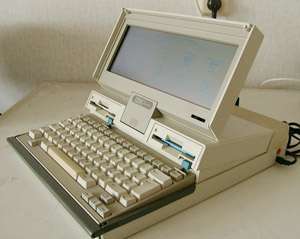IBM PC Convertible
The IBM PC Convertible is the first laptop computer released by IBM. Released on April 3, 1986, the Convertible was also the first IBM computer to use the 3½-inch floppy disk format which went on to become the industry standard. Like modern laptops, it featured power management and the ability to run from batteries.
 IBM PC Convertible | |
| Release date | April 3, 1986 |
|---|---|
| Introductory price | US$2,000 (equivalent to $4,665 in 2019) |
| Discontinued | August 7, 1989[1] |
| Operating system | IBM PC DOS with custom icon-oriented shell interface |
| CPU | Intel 8088 CPU @ 4.77 MHz |
| Memory | 256 KB of RAM (expandable to 640 KB) |
| Storage | Dual 720 KB 3.5-inch floppy drives |
| Display | Monochrome CGA-compatible LCD screen. |
| Graphics | 80x25 (text), 640x200, and 320x200 |
| Power | Battery: 9.6v/2400mAh (NiCd) Power supply: 15 VDC, 2.7A. |
| Mass | 13 pounds (5.8 kg) |
| Predecessor | IBM Portable Personal Computer |
| Successor | IBM PS/2 L40SX IBM PS/Note |
It was the follow-up to the IBM Portable and was model number 5140. It was replaced in 1991 by the IBM PS/2 L40 SX, and in Japan by the IBM Personal System/55note, which was the predecessor to the ThinkPad.
Predecessors
IBM engineers in 1983 reportedly developed a Tandy Model 100-like laptop, codenamed "Sweetpea", which Don Estridge rejected for not being PC compatible. In 1984 the larger LCD screen of another prototype ("P-14") reportedly failed the "Chiclet rule", especially after the poor reception of the Data General-One's display.[2]
Description
The PC Convertible used the CMOS version of the Intel 8088 CPU running at 4.77 MHz, 256 KB of RAM (expandable to 640 KB), dual 720 KB 3.5-inchfloppy drives, and a monochrome CGA-compatible LCD screen at a price of $2,000. It weighed 13 pounds (5.8 kg) and featured a built-in carrying handle.
The PC Convertible had expansion capabilities through a proprietary ISA bus-based port on the rear of the machine. Extension modules, including a small printer and a video output module, could be snapped into place. The machine could also take an internal modem, but there was no room for an internal hard disk. The concept and the design of the body was made by German industrial designer Richard Sapper.
Pressing the power button on the computer did not turn it off, but put the machine into "suspend" mode, which would hold in place as long as there was battery power. This avoided the long boot-up process. The CMOS 80C88 CPU has a static core, which held its state indefinitely by stopping the system clock oscillator. It can resume processing when the clock signal is restarted, as long as it is kept powered. The CMOS 80C88 processor used very little power while the clock signal is stopped. The system RAM in the Convertible is SRAM rather than DRAM, both for lower power consumption and less circuitry to fit into the cramped laptop case. The Convertible had 256K of RAM included, with 128k (and eventually also 256K) memory cards available. There was space for 4 memory cards in the system, so at least one of those has to be a 256K card in order to be able to upgrade the system to full 640K base memory.
The screen was only half the size of the lid, so text characters and graphics were compressed vertically, appearing half their normal height. The display was capable of 80x25 text and graphics modes of 640x200 and 320x200 pixels. Pressing a lever between the two floppy drives just below the display detached the entire screen from the unit. This feature allowed the convenient use of a full-size desktop monitor while at one's desk, an early forerunner of the "docking station" concept, as well as Apple's PowerBook Duo.
Reception
The machine sold very poorly for a number of reasons. The Convertible was heavy, not much faster than the Portable it replaced (despite the newer CMOS processor and use of static RAM), had no traditional PC expansion ports (such as serial ports and a parallel port) without an add-on, and had a hard-to-read, oddly-shaped LCD screen (the first screens lacked a backlight). It also competed against faster portables based on the Intel 80286 that offered optional hard drives, from companies such as Compaq, and laptops from companies such as Toshiba and Zenith that were lighter and offered similar specifications, sometimes at half the price. The keyboard was also widely criticized.
See also
- IBM Portable Personal Computer
- IBM PS/2 L40 SX
- IBM PS/55 note
- History of laptops
- Convertible (computer)
References
- "IBM 5140 PC Convertible Products and Selected Features Withdrawal From IBM Marketing: Announcement Letter Number 189-107" (Press release). International Business Machines Corporation. July 6, 1989. Retrieved May 27, 2020.
- Strehlo, Kevin (1985-06-17). "The Chiclet Rule and the Green Dragon". InfoWorld. p. 8. Retrieved 23 March 2016.
External links
- "IBM PC Convertible". IBM Archives. IBM. Retrieved September 11, 2006.
- "IBM Convertible 5140". Oh no, not another computer museum!. November 26, 2003. Retrieved September 11, 2006.
- IBM-5140 Convertible and collection of old digital and analog computers at oldcomputermuseum.com
- "IBM PC Convertible, 360 degree model", Russian Vintage Laptop Museum (museum)
| Preceded by IBM Portable Personal Computer |
IBM Personal Computers | Succeeded by IBM PS/2 L40 SX |